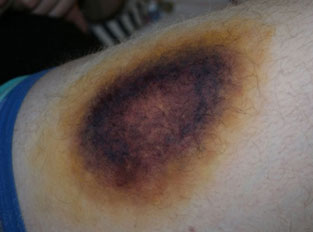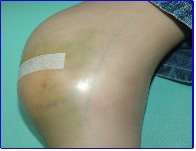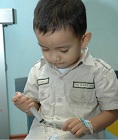What is Haemophilia?
Haemophilia is an inherited bleeding disorder, where within the affected individual’s blood there is reduction or lack of one of the blood clotting factors. This makes it difficult for the blood to form a clot, so bleeding continues longer but not faster than usual.
Haemophilia is a rare disease in which 1 in 10,000 people are born with it.
There are 2 types of Haemophilia. Haemophilia A is the most common type. This type lacks the clotting factor VIII. Haemophilia B is less common and this type lacks the clotting factor IX. However the symptoms are the same for both Haemophilia A and B, that is bleeding is longer than normal.
How do people get Haemophilia?
Haemophilia is usually inherited, meaning that it is passed on to the affected child through a parent’s genes. Sometimes Haemophilia can occur when there is no family history. This is called sporadic Haemophilia. About 30% of people are inflicted with this. It is caused by mutation of the genes.
When the father has Haemophilia but the mother does not, none of the sons will have Haemophilia. However all of the daughters will carry the Haemophilia gene and they will become carriers.
Women who are carriers can sometimes show signs of bleeding tendency. They can pass their abnormal gene to their children. When a carrier marries a normal adult male, there is a 50% chance that the sons will have Haemophilia and a 50% chance that the daughters will carry the gene.
Levels of severity
The level of severity depends on the amount of clotting factor that is lacking in a person’s blood and correlate well with seriousness of the bleeding problems. The 3 levels are described below.
NORMAL
50% – 150% of the normal activity of clotting Factor VIII (8) or IX (9) in the blood.
MILD HAEMOPHILIA
 |
5% – 30% of normal clotting factor activity. |
|
MODERATE HAEMOPHILIA
 |
1% – 5% of normal clotting factor activity. |
|
SEVERE HAEMOPHILIA
 |
Less than 1% is normal clotting factor activity. |
|
What are the signs of Haemophilia?
- Big bruises.
- Bleeding into muscles and joints, especially the knees, elbows, and ankles.
- Spontaneous bleeding (sudden bleeding inside the body for no clear reasons).
- Bleeding for a long time after getting a cut, tooth extraction, or having surgery.
- Bleeding for a long time after an accident, especially after an injury to the head.
- Bleeding into a joint or muscle causes:
- An ache or “funny feeling”.
- Swelling.
- Pain and stiffness.
- Difficulty using a joint or muscle.
 |
 |
Where does bleeding occur most often?
People with Haemophilia can bleed inside or outside the body.
If bleeding occurs many times in the same joint, the joint can become damaged and painful.
Repeated bleeding can cause other health problems like arthritis. This can make it difficult to walk or do simple activities.
How to avoid bleeding episodes?
- Continuous education for parents/caregivers/patients regarding haemophilia & ways to look after children in the early years.
- Avoid riding motorcycle/pillion riding. If no other options, make sure safety helmet is always worn. Avoid contact sports (football, rugby, boxing etc) and rough activities that carry high risk of injury.
- Ensure factor coverage prior to procedures such as tooth extraction or surgery.
- Avoid intramuscular injections (injections into the muscle) during vaccinations.
- Seek treatment early whenever there is a bleeding episode.
- Take proper care of young children when they are playing in or outside home to minimize injury.
- Inform school/institutional authority about child’s haemophilia condition so that they are given closer observation.
How is Haemophilia treated?
Treatment for Haemophilia today is very effective. The missing clotting factor is injected into the bloodstream using a needle.
Bleeding stops when adequate factor levels have been achieved.
- Treat bleeding quickly!
Quick treatment will help reduce pain and damage to the joints, muscles, and organs. If bleeding is treated quickly, less blood product is needed to stop the bleeding. - If in doubt, treat!
If you think you have a bleed, get treatment even if you are not sure. NEVER wait until a joint is hot, swollen, and painful. - There is no cure yet, but with treatment people with Haemophilia can live normal healthy lives. Without treatment, people with severe Haemophilia may find it difficult to go to school or work regularly. They might become physically disabled and have trouble walking or doing simple activities.
Adjunctive management
When there is an injury or discomfort, a good rule to follow for first aid is the RICE:
| R | – Rest the injury | : Bleeding muscles and joints can be kept at rest by splinting, casting or using crutches or a wheelchair. |
| I | – Ice | : Application of cold/ ice pack is useful to decrease inflammation but ice should be wrapped in a towel and not be applied directly to the skin. It is recommended that ice be applied for 10 minutes, for approximately 48-72 hours until swelling and pain decrease. |
| C | – Compress the Injury | : Compress the site of injury using the compression bandage to reduce the swelling. |
| E | – Elevate the site of injury above your heart | : It allows the blood and body fluid flow back to the heart and prevents more swelling and minimizes internal bleeding. |
When should treatment be given?
Treatment is given for:
- Bleeding into joint.
- Bleeding into muscles, especially in the arm or leg.
- Injury to the neck, mouth, tongue, face, or eye.
- Severe blows to the head and unusual headaches.
- Heavy or persistent bleeding from any site.
- Severe pain or swelling in any site.
- All open wounds requiring stitches.
- Following any accident that may result in a bleed.
Treatment is given before:
- Surgery, including dental procedure, circumcision or any minor/major operation.
 |
 |
Potential Complications
- Spontaneous bleeds into the joints and not treated immediately can lead to recurrent bleeding into the same joint that cause the synovium (lining) to swell and bleed very easily.
- This damages the smooth cartilage that covers the ends of the bones. The joint becomes stiff, painful to move, and unstable. It becomes more unstable as muscles around the joint weaken.
- With time, most of the cartilage breaks down and some bone wears away. Sometimes the joint cannot move at all. The whole process is called hemophilic arthritis.
- After repeated bleeds, muscles can become weak (muscle atrophy.) The muscles can no longer protect the joints.
- Bleeding within the head if not treated immediately and adequately can lead to permanent damage and death.
- Bleeding into important muscles especially in the hip and groin area can lead to recurrent bleeding if not adequately treated. These repeated bleeds into the muscles can lead to weakness of the muscles, scarring and shorting (fibrosis) leading to permanent deformity.
Conditions That May Not Require Treatment
- Small bruises are common in children with Haemophilia, but they are not usually dangerous. However, bruises on the head might become serious, and should be checked by doctor.
- Small cuts and scratches will bleed for the same amount of time as in a normal person. They are not usually dangerous.
- Nose bleeds: Putting pressure on the nose for five minutes can usually stop nose bleeds. If bleeding is heavy or does not stop, treatment is needed.
Important points for Haemophilia Patients and people living with them:
- Treat bleeding quickly!
When you stop bleeding quickly, you have less pain, and less damage to joints, muscles, and organs. Also, you need less treatment to control the bleeding. - Stay fit.
Strong muscles help protect you from joint problems and spontaneous bleeding (bleeding for no clear reasons). Ask your Haemophilia doctor or physiotherapist which sports and exercises are best for you. - Do not take ASA (Aspirin).
ASA (acetylsalicylic acid) and aspirin related tablets can cause more bleeding. Other drugs can also affect clotting. Always ask your doctor which medicine is safe. The following drugs can normally be used safely. In prescribed doses and on medical advice: Paracetamol (Panadol), Tramadol (Tramal), Celecoxib (Celebrex), Arcoxia, Dihydrocodeine (DF118) . - See a Haemophilia doctor or nurse regularly.
The staff at Haemophilia clinic or treatment centre will offer help and advice about managing your health. - Avoid injections into your muscles.
Injection into the muscle could cause bleeding and swelling of the affected muscle, for example during vaccination. An alternative treatment is by giving subcutaneous injections during vaccination. - Take care of your teeth.
To prevent problems, follow the advice of your dentist. Dental injections and surgery can cause major bleeding. Thus, dental care during the early years is very important in preventing disease of the teeth and gums. - Carry medical identification with information about your health.
Bring along Haemophilia card and wear “Medic Alert” all the time. - Learn basic first aid. Quick aid help manage bleeding.
Remember that very small cuts, scratches, and bruises are usually not dangerous. They do not usually need treatment. First aid is often enough. - Learn and understand as much as possible about the disease.
| Last Reviewed | : | 28 August 2020 |
| Writer | : | Dato Dr. Faraizah bt. Dato Abd. Karim |
| Reviewer | : | Dr. Jubaida Paraja |







